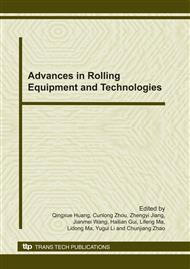p.443
p.449
p.453
p.458
p.462
p.467
p.471
p.477
p.482
Industrial Test on Shearing Force of Rolling Shear
Abstract:
The accuracy of the max shear force of rolling shear is of vital importance to the proper selection of motor power and the optimization design of structure strength. The test on shear force during the shearing process of stainless steel was done on 3000 mm cut-to-length rolling shear of some Large-scale Iron & Steel Co., Ltd. The test results have shown that the weight of upper-blade carrier can bring about the fluctuation of measuring signals of shearing force at the start and end instants. Meanwhile, the shear force during the shearing process will gradually increase with the increment relative cut-in depth, and the process from the bite-in of upper blade into steel plate to the fracture of steel plate is very short, thus the link force on the side of firstly-fallen-off blade will initially increase and then will decrease by large increment amplitude. The shear force at the cut-in stage will dramatically increase. During the cut-in stage, the shear force is basically a constant due to the constant shear angle. In summary, the above test results have important referential value to the calculation of shear force and the design of structure strength.
Info:
Periodical:
Pages:
462-466
Citation:
Online since:
October 2010
Authors:
Keywords:
Price:
Сopyright:
© 2011 Trans Tech Publications Ltd. All Rights Reserved
Share:
Citation:


